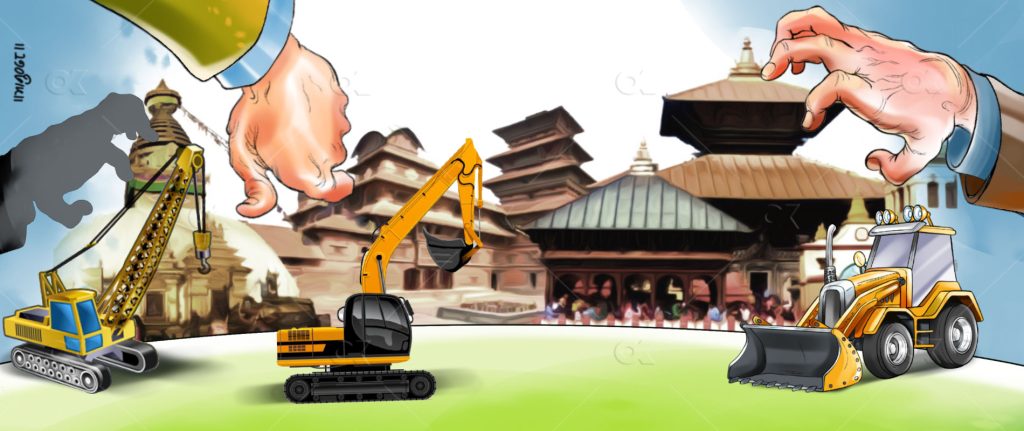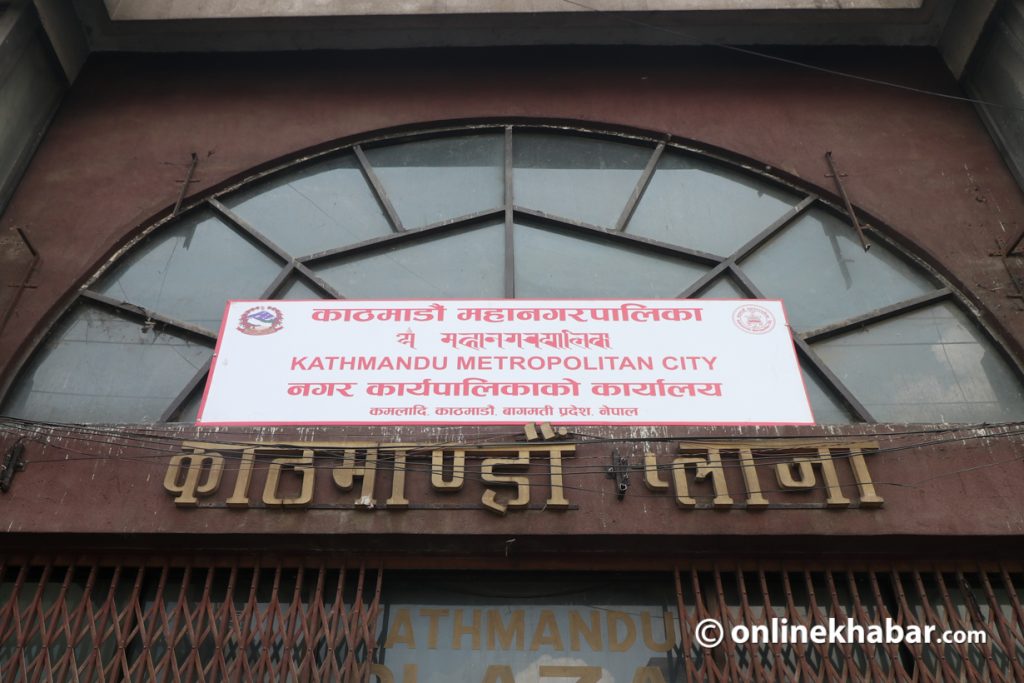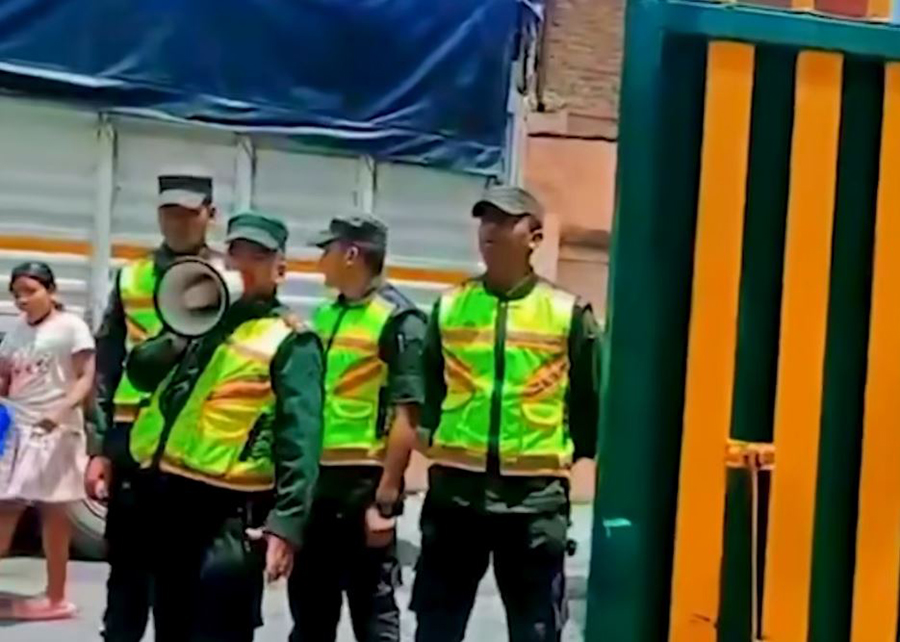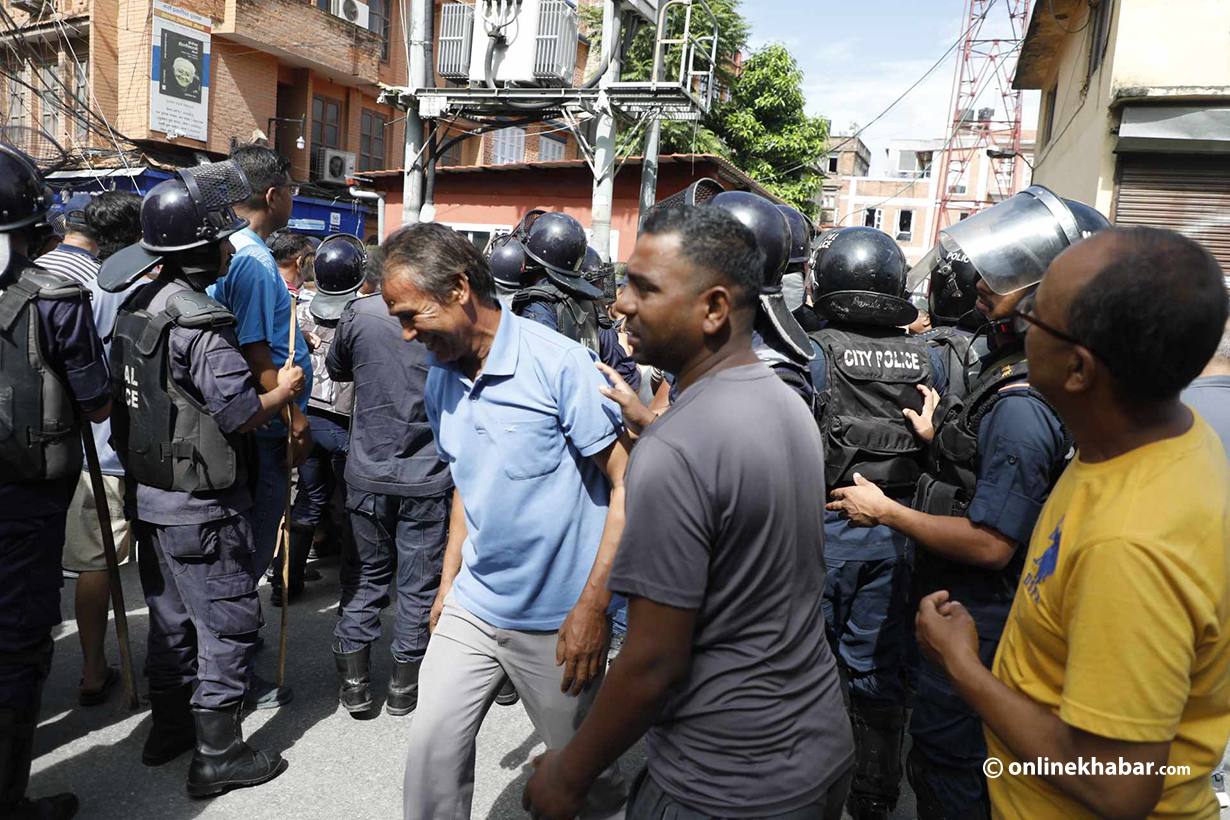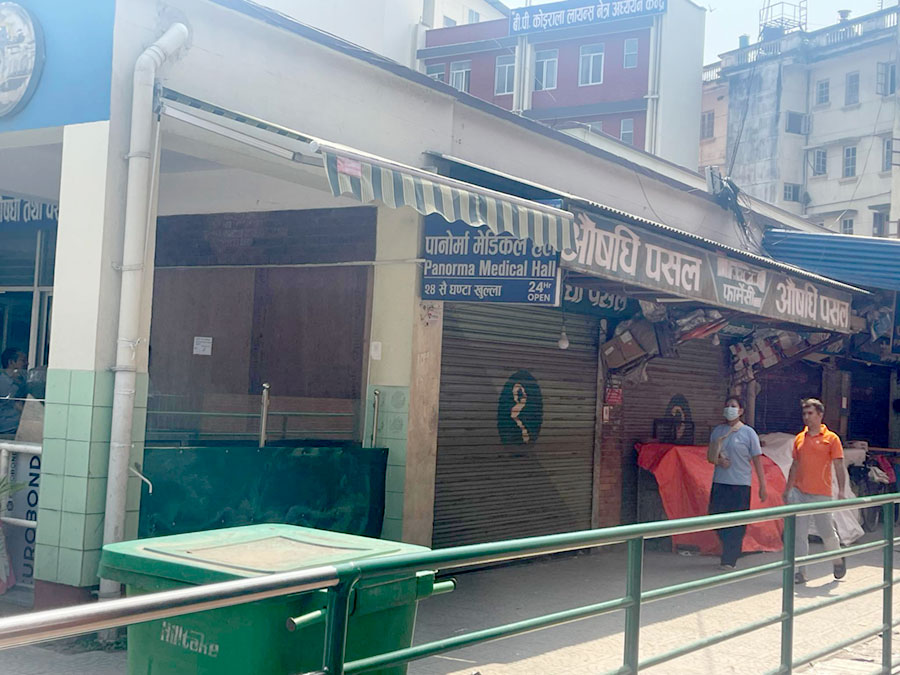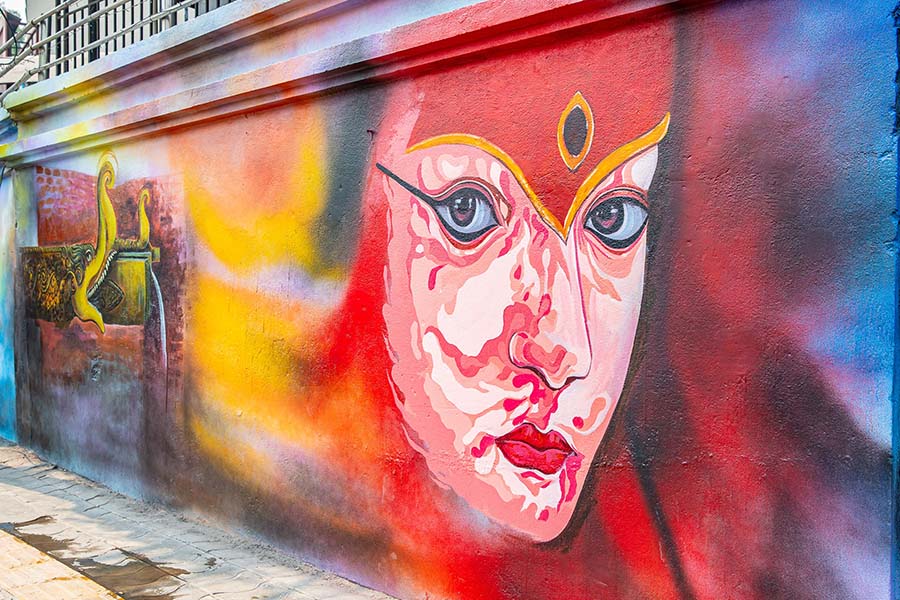After the 2015 earthquake, various stakeholders in Nepal stepped up efforts to rebuild the fallen heritage monuments across the country. One of the first areas to start restoration and rebuilding was Swayambhu, a UNESCO World Heritage area, where some of its vihars/bihars (monastic complexes) had been heavily damaged.
However, as the restoration work started, it was smeared in controversy. The first problem that started with the restoration was the use of concrete during the construction of a vihar. As Swayambhu is a UNESCO-certified World Heritage area, the use of concrete should have been prohibited. Instead of halting the work, the stakeholders covered the area so people could not see and carried on. The building was built and was inaugurated by parliamentarian Jeevan Ram Shrestha on April 26, 2021.
As this has happened, it kick-started an important debate about the existence of concrete buildings on a World Heritage site. Citing the risk of landslides, experts in the past suggested that all heavy concrete buildings on the hill be destroyed. But, that has not happened as new buildings continue to pop up on the hill.
Swayambhu is not the only place where this has happened, but World Heritage areas across the city face a similar problem. These sites, which were once surrounded by traditional buildings have seen a complete makeover in the name of the post-earthquake reconstruction as most have been replaced by concrete houses. This has resulted in Kathmandu at the risk of being listed as a World Heritage Site in Danger by UNESCO’s World Heritage Committee. Despite this, things have not improved as the haphazard conduction of buildings near heritage monuments continue to increase as local leaders and government bodies choose to turn a blind eye.
Widespread apathy

Although the encroachment on the World Heritage site seems more rampant following the 2015 earthquake, this trend has continued for the past few decades, according to experts.
A former official at the Department of Archaeology Bhim Nepal says that construction of new monuments continues in World Heritage areas despite people knowing that there will be negative consequences. Citing the example of Swayambhu, Nepal says if concerned authorities do not do anything to stop the construction of new monuments around, there is a high chance of landslides damaging the entire Swayambhu area.
Heritage management expert Kai Weise says a team had advised the government to relocate the people from the hill, but he says no one took the warning seriously as the locals and priests of the temples on the hill were adamant that they be allowed to reconstruct their houses, shops and temples.
In 2017, structural engineer Andres Arce prepared a report where he suggested people not make heavy buildings on the hilltop due to the risk of soil erosion. He also recommended all non-historical buildings be removed from the hill for the sake of the chaitya.
This was not the first warning. Many researchers and archaeologists have warned of this. In 1989, the government even prepared a master plan to make the place free of buildings that hampered the iconic monument. But, the plan was hardly implemented, experts say. A report in 1982 has stated the same thing where researchers have asked not to build any more buildings on the hill as the monastery was quite big and heavy enough.
Despite this, people continued to make buildings on the hill risking the very existence of Swayambhu chaitya which is over a millennium old. What is odd is, none of the new buildings took permission from the heritage section at the Department of Archaeology which has puzzled officials there.
Things are even worse at Basantapur where big commercial buildings are being built near the World Heritage monuments.
When the local authorities gave Krishna Lal Maharjan permission to build a commercial complex in Basantapur Durbar Square, they had told him to follow certain rules. The first rule was each floor could only go as high as 7.7 ft. But according to government data, all floors are 10.7 ft in height. This was a huge issue as the Ancient Monument Preservation Act does not allow the construction of buildings taller than 35 feet in heritage sites.
Another problem with the building is it also has a basement which is extremely close to a preserved dhukuti ghar (treasury). Heritage activists like Ganapati Lal Shrestha showed concern and asked the government to look into it as there were also calls for the building’s demolition. Shrestha says that the complex has also encroached on a Kumari temple along with being the reason for a dry pond in the palace complex.
Questions on authorities’ accountability

Activists appealed to the Kathmandu metropolitan city to take action against the complex.
But, rather than upholding the government criteria and taking action against the company, the city government drafted its own rules that would help Krishna Lal Maharjan build the Maharjan Complex in the manner he wanted.
UNESCO itself was also shown in a bad light here. In a letter it sent to campaigners and the contractors, it highlighted that the building did not fall in the World Heritage zone. Heritage activists and the department were quite angry about this as UNESCO, which had stated that the building was against the set rules, had changed its view in less than a month. After constant protests, the height of the building did not go beyond 35 ft, which activists felt was a success.
But, their joy did not last long as huge houses started being built around Kumari Ghar, another World Heritage monument. Even though the owners of these houses were told to follow all rules and regulations, they discarded the letters and built the houses anyway.
Gautam Ratna Shakya, the coordinator of the Indra Jatra Management Committee, says that these houses risk the existence and the importance of the Kumari Ghar.
“They can see what’s going on inside the Kumar Ghar. The Kumari is a revered goddess, and what happened is wrong,” says Shakya, adding locals even wrote to the mayor’s office but received no response.
The chairperson of the ward where the buildings are is questioning why the department or the locals did not come and complain when the foundations of these houses were being laid.
“Our job is to approve the design of the house. If they’d come to us earlier, we could have done something, but now we can’t,” says Macharaj Maharjan, the chairman of Kathmandu metropolitan city’s ward number 23.
But, locals say they did complain and that the construction of these houses during the Covid-19 pandemic was only possible thanks to local officials.
Everyone’s protector needs his protector

The Pashupatinath temple, another World Heritage monument, is facing similar issues. Recently, a park has been constructed near the Bankali temple in the Pashupati area. Authorities had asked the Radha Madhav Sewa Committee to not have such a place in the temple compound, but it refused to budge, which is risking the significance of the entire heritage site. Heritage activists say that while the park does not hamper the heritage site, they do feel that it does affect the intangible heritage.
The department had written to the committee to remove the park, but there has been no progress. This issue has even reached the council of ministers.
The Pashupati Area Development Trust also says it will not be removing the park but managing it in a way that keeps the intangible heritage of the area intact. The trust’s executive director Ghanashyam Khatiwada says he is aware of the issue and is working on it.
Former department official Bhim Nepal says if the park is not removed, there is a chance that the area will be the reason why Kathmandu will yet again be put on the list of World Heritage in Danger.
“We need to think twice before we build anything around the World Heritage zones,” says Nepal.
What happens when people do not think and build things around heritage areas can be learnt through one example in Bouddhanath. In the early 2000s, a team from UNESCO visited a house in Bouddha which was in a sorry state and asked the owners not to demolish it.
But, the owners did not listen to UNESCO and decided to demolish it. When the Department of Archaeology and the District Administration Office found out about this, they set a team to stop the owners. A tussle ensued between locals and the government officials sd the locals demanded they should be allowed to build new houses. Following that, one of the largest chaityas is surrounded by concrete houses. Today, the houses, which once were a part of the World Heritage site, have been removed from it, and only the main chaitya and the pathway are listed as heritage.
Persistent danger

Bouddhanth, Pashupatinath, Swayambhunath and Basantapur Durbar Square are a few heritage monuments in the valley which is a UNESCO World Heritage site. While there are some monuments where there have not been many problems, there is a risk of Kathmandu being taken off the World Heritage list even if there is a problem in one out of the seven heritage monuments.
UNESCO officials have been warning time and again that Kathmandu is in danger of being removed from the list due to the haphazard construction of buildings around these heritage monuments.
Ever since the earthquake, UNESCO, every year, has been thinking about putting Kathmandu on the World Heritage in Danger list. Kai Weise says every year people recommend that Kathmandu be put on the danger list but somehow always misses out on it at the last moment.
The Kathmandu valley has been put up at risk since 2003 due to the valley’s haphazard urbanisation. Since then, UNESCO officials have been coming to Kathmandu to see if things have changed. They even meet high ranking government officials including the prime ministers asking them to take things seriously.
After that, the department tried to start raising awareness that even private houses were part of the World Heritage zone and started encouraging people to save these old houses.
Former DOA official Nepal says that UNESCO had clearly stated that Kathmandu was vulnerable due to concrete houses that were popping up.
The 2015 earthquake did not help either as the government did not encourage the restoration of these old houses. People, afraid of another quake, started to build houses that they felt were safe. That meant using concrete and beams. And, that has resulted in Kathmandu being turned into a concrete jungle.
“It’s likely that we’ll be put in the list of World Heritage in Danger and it is completely our fault,” says an official from the department.



